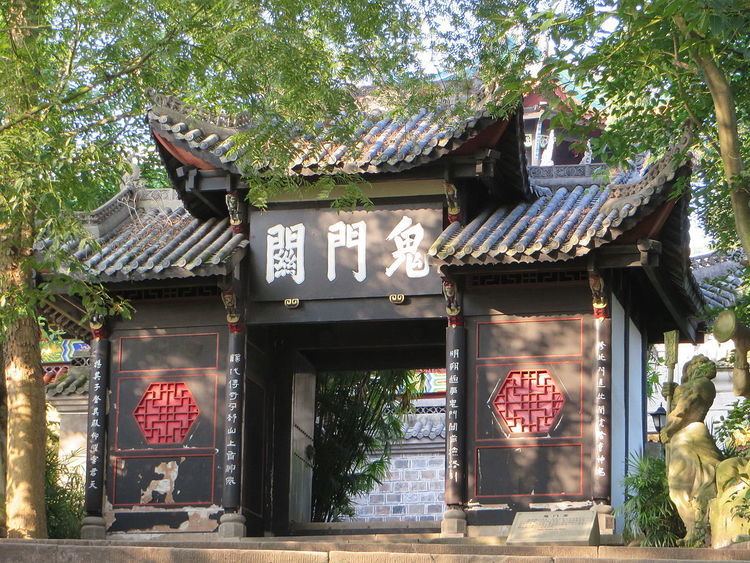 | ||
The gates of hell are various places on the surface of the world that have acquired a legendary reputation for being entrances to the underworld. Often they are found in regions of unusual geological activity, particularly volcanic areas, or sometimes at lakes, caves or mountains.
Contents
Gates in the Greco-Roman world
Legends from both ancient Greece and Rome record stories of mortals who entered or were abducted into the netherworld through such gates. Aeneas visited the underworld, entering through a cave at the edge of Lake Avernus on the Bay of Naples. Hercules entered the Underworld from this same spot.
In the middle of the Roman Forum is another entrance, Lacus Curtius, where according to legend, a Roman soldier, named Curtius, bravely rode his horse into the entrance in a successful effort to close it, although both he and his horse perished in the deed.
Lerna lake was one of the entrances to the Underworld.
Odysseus visited the Underworld, entering through river Acheron in northwest Greece.
Orpheus traveled to the Greek underworld in search of Eurydice by entering a cave at Taenarum or Cape Tenaron on the southern tip of the Peloponnese.
Pluto's Gate, Ploutonion in Greek, Plutonium in Latin, in modern-day Turkey unearthed by Italian archaeologists is said to be the entry gate to the Underworld; it is linked to the Greco-Roman mythology and tradition.
Rivers Cocytus, Lethe, Phlegethon and Styx were also entrances to the Underworld.
The god Hades kidnapped the goddess Persephone from a field in Sicily and led her to the Underworld through a cleft in the earth so he could marry her.
Medieval gates
Into the medieval period, Mount Etna on Sicily was considered to be an entryway to hell.
The gates of hell were commonly depicted as jaws, forming the Hellmouth, which was simultaneously the entrance to hell and the mouth of a huge monster.
Art
Auguste Rodin was commissioned to make a pair of bronze doors to symbolize the gates of hell. He received the commission on August 20, 1880 for a new art museum in Paris, to exhibit at the 1889 Exposition Universelle, which ultimately did not open; however in 1900, some of them were part of his first solo exhibition in Paris. Rodin spent seven years making the doors, with over 200 figures appearing on it. He was first inspired by Dante's Inferno but focused more on universal human emotions. During his lifetime the model was never cast and it was first cast in 1925. The Gates of Hell was described as one of the defining works of Rodin. Having hoped to exhibit his Gates at the 1889 Exposition Universelle, but probably too busy to finish them, the sculptor stopped working on them circa 1890.
Other gates
In China, Fengdu has a long history in the Taoist tradition of being a portal to hell.
Hellam Township near York, Pennsylvania, is the subject of a modern urban legend claiming that it contains the Seven Gates of Hell.
In Derweze, Turkmenistan a burning natural gas fire in the middle of the Karakum Desert is known as the Door to Hell.
Mount Osore in northern Japan is said to be an entrance to hell.
On the north western-most army outpost in India, during the India Chinese war in 1962, the snow covered Murgo ("the gateway of death" in Yarkandi, Uyghur) where Chinese army advance stopped is called the Gate of Hell by the Yarkandi tribal people who cross Karakoram Pass with their caravans.
Religious contexts
In 1878, Rev. Thomas De Witt Talmage delivered a widely reprinted sermon titled "The Gates of Hell" at the Brooklyn Tabernacle, based on the scripture Matthew 16:18, message by Jesus to Peter "...on this rock, I will build my church, and the gates of Hell shall not prevail against it." Talmage's gates were metaphorical, including "infamous literature," "dissolute dance," "indiscreet apparel," and "alcoholic beverage".
In ancient Indian Hindu tradition the Orion constellation where the vernal equinox is stated to occur, the Milky Way and the Canis were considered to form the border between Devaloka (heaven) and Yamaloka (hell); the Milky Way forming the dividing river between heaven and hell and the Canis Major and Canis Minor representing dogs that guarded the Gates of Hell.
